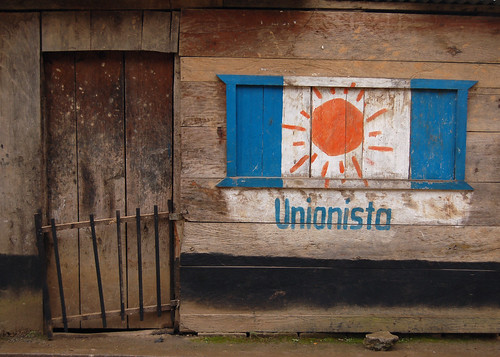 Guatemalan elections happened on Sunday, September 9. The Holla staff hasn't been in Guatemala for well over a month at this point, so we can't provide any first-hand information about the election or the winners. As of this writing, no results are available, but the expected result is a run-off between the center-left UNE candidate and the right-wing Partida Patriota, which will mean weeks more campaigning.
Guatemalan elections happened on Sunday, September 9. The Holla staff hasn't been in Guatemala for well over a month at this point, so we can't provide any first-hand information about the election or the winners. As of this writing, no results are available, but the expected result is a run-off between the center-left UNE candidate and the right-wing Partida Patriota, which will mean weeks more campaigning.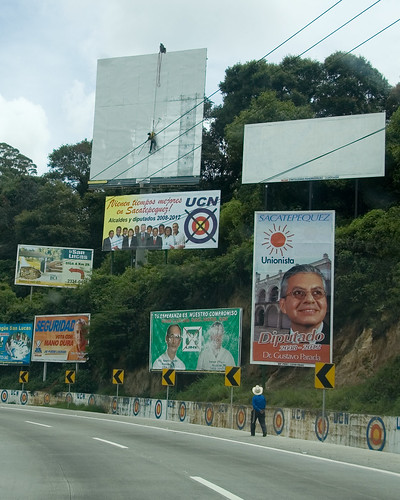 As in the U.S., the campaign in Guatemala includes television ads (clearly lower budget, the ones I saw were mostly just the candidate speaking to the camera); radio ads, often featuring full-length jaunty theme songs (particularly fun was a peppy Patriota salsa number with a cheery chorus refrain of Mano Dura!, literally "firm hand," but "iron fist" wouldn't be a bad translation); and billboards (uniformly basic with often unflattering pictures of the candidates, a name, and maybe a slogan). As in the U.S., it seems that every commercial space during campaign season is filled with a political ad -- the perilously dangling worker here is probably putting up an ad for the GANA, the biggest party not represented in the other billboards in the picture (click on the picture for a better view of the surely not-at-all-unsafe job).
As in the U.S., the campaign in Guatemala includes television ads (clearly lower budget, the ones I saw were mostly just the candidate speaking to the camera); radio ads, often featuring full-length jaunty theme songs (particularly fun was a peppy Patriota salsa number with a cheery chorus refrain of Mano Dura!, literally "firm hand," but "iron fist" wouldn't be a bad translation); and billboards (uniformly basic with often unflattering pictures of the candidates, a name, and maybe a slogan). As in the U.S., it seems that every commercial space during campaign season is filled with a political ad -- the perilously dangling worker here is probably putting up an ad for the GANA, the biggest party not represented in the other billboards in the picture (click on the picture for a better view of the surely not-at-all-unsafe job). 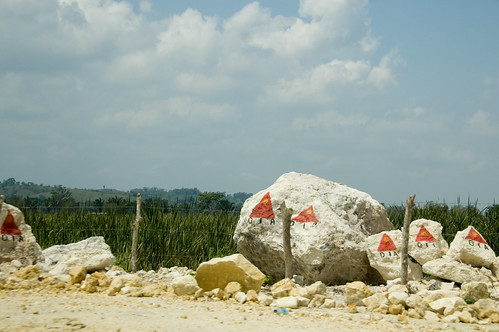 One local campaign tactic that you don't see so much in the U.S. is official graffiti. The political graffiti in Guatemala is ubiquitous. These are not simple spray-painted slogans; many are wall-sized murals, and all are clearly the result of party-sponsored efforts, despite the fact that such graffiti is technically illegal. There are stretches where every tree or rock (as above, on a road to Belize in the middle of nowhere) for hundreds of yards on end is painted with the logo of one political party. The law-and-order candidates endorsed by the graffiti are perhaps not fans of the "broken windows" approach to tackling big crime by first showing zero tolerance for little crimes.
One local campaign tactic that you don't see so much in the U.S. is official graffiti. The political graffiti in Guatemala is ubiquitous. These are not simple spray-painted slogans; many are wall-sized murals, and all are clearly the result of party-sponsored efforts, despite the fact that such graffiti is technically illegal. There are stretches where every tree or rock (as above, on a road to Belize in the middle of nowhere) for hundreds of yards on end is painted with the logo of one political party. The law-and-order candidates endorsed by the graffiti are perhaps not fans of the "broken windows" approach to tackling big crime by first showing zero tolerance for little crimes.The key to this style of campaign is the simple set of identifiers attached to each campaign. Almost every party has one primary color associated with it, although there is a little overlap. For example, the Patriotas are orange, and the UNE is green. So all you have to do is see that a stretch of highway has its rocks painted yellow to know that the PAN party has been there. On top of this, each party has a simple logo:
 The Patriotas have their fist (as you can see, not all the sign-painters are highly trained pros; the monstrously large thumb here is by no means the worst attempt at a fist that your correspondents saw).
The Patriotas have their fist (as you can see, not all the sign-painters are highly trained pros; the monstrously large thumb here is by no means the worst attempt at a fist that your correspondents saw). 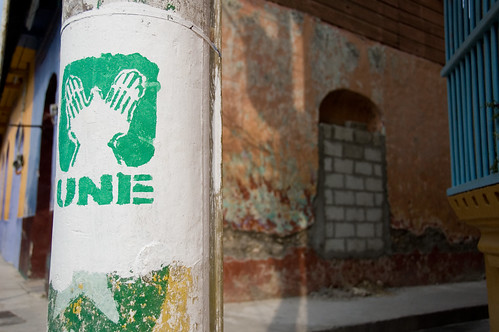 The UNE features a pair of hands making a bird.
The UNE features a pair of hands making a bird. 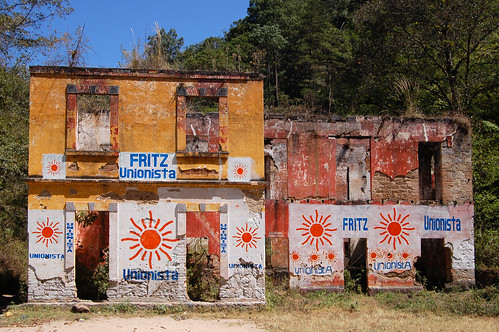 The Unionista party uses a shining sun as their symbol ("Fritz" is the name of their candidate. His running mate is named "Quique".)
The Unionista party uses a shining sun as their symbol ("Fritz" is the name of their candidate. His running mate is named "Quique".) 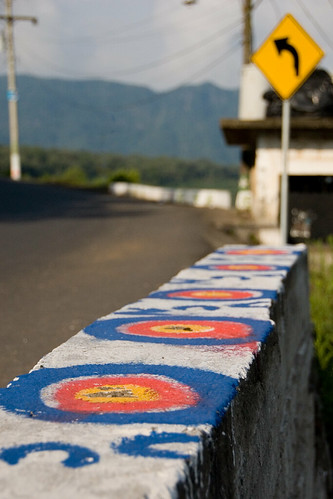 The UCN has a target.
The UCN has a target. 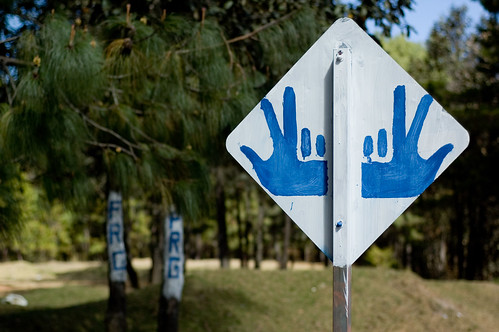 The FRG has a hand holding out three fingers.
The FRG has a hand holding out three fingers. 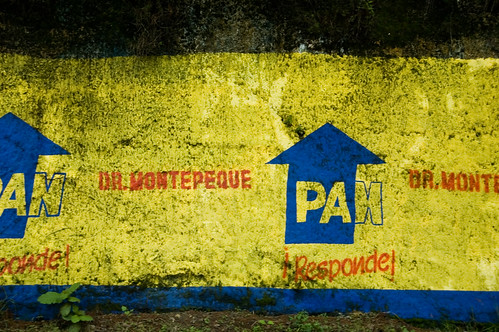 The PAN uses a blue italicized arrow.
The PAN uses a blue italicized arrow. Rigoberta Menchú's Encunetro por Guatemala party has a circular red-and-green symbol that this viewer thought of as a Christmas wreath and that isn't usually blurry except when photographed from a moving car.
Rigoberta Menchú's Encunetro por Guatemala party has a circular red-and-green symbol that this viewer thought of as a Christmas wreath and that isn't usually blurry except when photographed from a moving car. The outgoing ruling party, the GANA, uses a Mayan pyramid. Somehow, we failed to take an interesting picture of one, though. The symbols are so well-known that the party's name doesn't necessarily need to appear -- and they need to be. The ballot features the party's logo, so the voter doesn't need to do any reading, they just need to mark the red triangle if they want to vote for the DIA or the Pepsi logo-turned-into-a-fish for the Bienestar party. Local parties are in the mix, too, with more stenciled lavender cowboy hat or tractor symbols. One personal favorite is the "Mixco Renewal Movement," which appropriately chose a broom as their symbol.
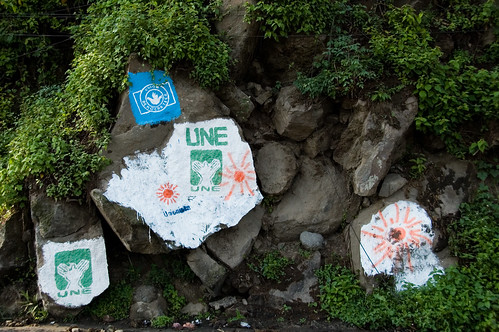
Since the graffiti are illegal in the first place, nobody seems to be regulating one party painting over another's logos. There was occasional re-use of spaces, but some sort of code of graffiti artist honor seems to have sprung up, as many parties seem to put their tags side-by-side rather than covering each others' stuff. Of course, rogue hooligans throw trash or tar or paint at opposing parties' graffiti, but no more frequently than they deface the billboards.
For a few more exciting pictures of Guatemalan political advertising in its many forms, see the full set of pictures at flickr. Disclaimer: This is intended to present to non-Guatemalan audiences a unique element of Guatemalan campaign season. In no way is any of this intended to endorse any party. Every party does this stuff, about equally.




No comments:
Post a Comment